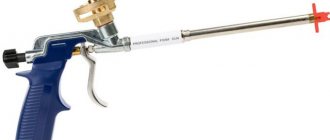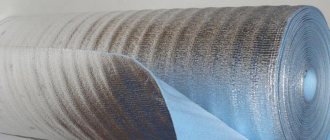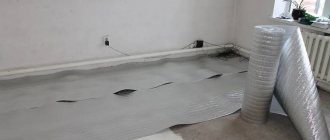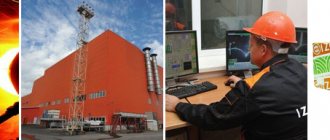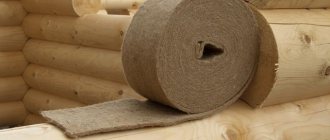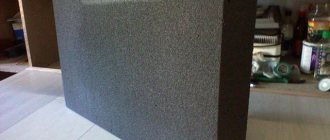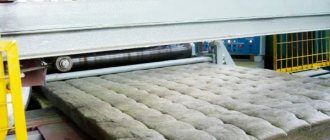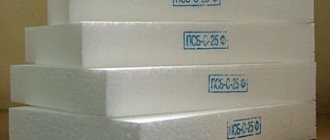“If it’s a car, then it’s Mercedes, if it’s insulation, then it’s Ursa (URSA)” - and this statement really holds true. Founded in 2002, the Spanish-German brand has proven to everyone who is boss.
According to the Global Research & Data Services “Insulation” study, in 2010 the company was the Russian market leader in the manufacture of fiberglass products.
It’s enough to go to any hardware store and our hero will definitely be among the famous manufacturers. Why is URSA mineral wool so good? The technical specifications will show a clear answer to this question.
Product line
Few people know that in fact the URSA concern is part of the URALITA company (Uralit), which has 4 main areas of activity:
- Pipelines;
- Thermal insulation;
- Plaster;
- Roofing materials.
The URSA brand represents the second group - thermal insulation materials. The company’s marketers did not torment customers with a huge line, but divided all products into 5 main groups:
- GEO;
- PUREONE;
- TERRE;
- XPS;
- SECO.
The last two are extruded polystyrene foam products and insulating membranes. In today's article we are talking about URSA glass wool, so we will focus on the first three points. Ursa insulation, both in rolls and in slabs, is made of fiberglass.
URSA GEO - fiberglass rules
Ursa Geo materials are considered the most popular type of this line. At the moment, this modification has twenty varieties, from universal, general purpose, to narrow-profile, specialized.
The company itself positions this product as glass wool for noise protection and thermal insulation. It is recommended to use this type of material for insulation:
- Facades;
- Pitched roofs;
- Loggias and balconies;
- Partitions;
- Ceilings and floors;
- Baths and saunas;
- Including industrial insulation.
Of course, this is only a conditional list. This direction is distinguished by the name “GEO” to emphasize the environmental friendliness of the insulation.
Main characteristics of URSA GEO insulation:
- Thermal conductivity coefficient: 0.035-0.044 W/m*C;
- Moisture absorption: no more than 1 kg/square meter;
- Flammability group: NG (non-flammable);
- Temperature range: -60 to +300 degrees Celsius.
Below in the table: Ursa technical characteristics of the GEO line
| Characteristics: Ursa Geo insulation and description | |||
| Name | Purpose | Form factor | Predominant construction area |
| GEO M-11 | Universal | Roll | Private |
| URSA GEO Mini | URSAmini repeats the features of its parent product, but has a more compact size | ||
| Geo Private House | A universal product for apartments and houses. Packing 20 square meters | ||
| Geo Universal Plates | For private use, recommended for facades and other walls. | ||
| Ursa Light (Geo Kf) | For private houses and apartments. The rolled type of material does not imply use on facades, but only in unloaded structures, for example, for filing in plasterboard partitions. | ||
| Geo Pitched Roof | The main scope of application is clear from the name. Product Feature: Pre-cut. Part of the roll can be separated without using a knife | ||
| Geo 37 RN Comfort | The manufacturer recommends for walls of frame houses, roofs and attic floors | ||
| GEO Noise protection | The name speaks for itself. According to the company, the level of penetrating noise is reduced by 2-3 times. | ||
| GEO Frame | Scope of application: professional construction - especially frame houses. | ||
| GEO M-11F | The letter "f" in the name means "foil". The element of this model: saunas and baths are rooms with high humidity. | ||
| GEO M-15 | Partitions, pitched roofs | Professional | |
| GEO M-25 | Insulating material for pipelines with temperatures not exceeding 270 degrees | ||
| GEO M-25F | The letter "F" also indicates foil. The insulation has a vapor barrier layer. It is used for pipelines with a surface temperature of at least +20 degrees. | ||
| URSAGEOfaçade | Designed for ventilated facades. | Plates | |
| Geo P 15 | Frame walls and partitions. | ||
| Geo P 20 | Insulation for suspended facades | ||
| Geo P 30 | Designed for three-layer walls. Can be used in multi-storey buildings. | ||
| Geo P 35 | Plates are vibration resistant. For example, they can be used to insulate railway cars. | ||
| Geo P 45 | More rigid plates than P35, but retaining their resistance to vibration. | ||
| Geo P 60 | Soundproofing of floating floors. The noise level can be reduced by 30 dB. |
GEO fiberglass insulation can be used in a wide variety of conditions. For example, there are specialized options like URSA GEO Facade. There are also more universal ones. For example, URSA MINI is used for a wide variety of purposes.
Technical parameters of Ursa insulation types
Silicone Ursa Geo
Ursa roll insulation has the ability to save heat, and very well. The fact is that its fibers are long and elastic, and because many air layers appear between them. By insulating a house with such a heat insulator, you can be sure that its wall surfaces will not freeze in the winter season. The thermal conductivity coefficient will determine how good this type of insulation is. The lower the value of this parameter, the better the material will conserve heat. If we talk about Ursa Geo, then the figure is 0.035-0.044 W*m*K, depending on the type of insulation. In terms of the degree of noise attenuation, such insulation is also excellent, and it can have a sound absorption class of either “A” or “B”. This has been proven by both practical results and laboratory studies. In general, all fiberglass materials are excellent at blocking sound waves. For this reason, if you need to create a partition for sound insulation in an apartment, then we suggest considering one of these materials as one of the variations.
Now what about environmental friendliness? Even at the moment of preparation of raw materials, a thorough check of each of the components will take place. Ursa Geo insulation in its finished form is still tested for safety for nature and humans. Let us take as an example the emission of volatile compounds in such a material. And it is 10-15 times less than European and Russian regulatory indicators. So with this type of insulation, your home will always have clean air and a pleasant microclimate. At the same time, it is necessary to remember that all fiberglass-type materials generate a little dust and therefore the walls of the internal parts of the room must be covered with membranes for waterproofing. The mineral thermal insulator Ursa Geo does not take fire - it is made on the basis of quartz sand. Such natural material is not capable of catching fire. And if he encounters an open fire, he will not let him go further into the room.
This type of insulation is not at risk of old age. Even after a long time, it will remain the same as it was at the very beginning. Neither its various positive qualities nor its strength will change. And manufacturers guarantee a service life of at least 50 years. Biological stability - since this substance is of an inorganic type, mice, beauties and insects definitely do not like it. It also does not harbor harmful microscopic organisms, such as mold. The fact is that all such living creatures simply have nothing to eat, so they do not live in Ursa Geo, avoiding it. Please note that all materials in this group are fiberglass with all the attendant advantages and disadvantages.
Innovative insulation Ursa PureOne
This is the latest technology, which was primarily used by Europe and Russia, and it began to successfully spread throughout the world. It is through it that such material is made. The essence of the technology is that acrylic is used as one of the binding components - it is a chemically safe and neutral polymer for human health. For this reason, fiberglass is not very prickly as with conventional production technology and produces less dust. Acrylic is a very inert material; it is not dissolved by water and will not oxidize the air. For this reason, insulation of this type can be used in hospitals and kindergartens.
As for noise absorption as characteristics of the Ursa PureOne insulating material, they were confirmed by tests of scientists from the NIISF of the Russian Scientific Academy. According to research, a slab-type material has a sound absorption class of “A”, and a material that looks like cotton wool has a class “B”. The elastic acrylic included in the composition can perfectly absorb sound waves. For this reason, partitions made of such material protect against noise better than stone wool or glass fibers. The difference can be 2 dB. In addition, such insulation material is more elastic than simple fiberglass. They even talk about a special “spring effect” that appears inside it. For this reason, it is tightly fixed in wall cavities, rigidly installed in the spacer, and its shape will not change over time. The properties that distinguish it favorably from GEO insulation are listed above.
Expanded polystyrene insulation XPS
Ursa insulation in rolls or slabs is very durable. This material has an excellent degree of strength, as well as increased resistance to wear and deformation. At the same time, it can withstand not only stretching and compression with honor, but will also resist bending perfectly. Ursa XPS can withstand 50 tons of load applied to one square meter. The material is also environmentally friendly. In the manufacture of such a thermal insulator, carbon dioxide CO2 is used, which is not a toxic substance at all. All breathing living organisms (including you and me) secrete it. For this reason, neither the production process of this type of insulation nor the finished product poses any harm to nature and humans. But we must not forget that this is polystyrene foam, which releases toxic substances when exposed to high temperatures.
Waterproof - Ursa XPS thermal insulation material will not absorb water. For this reason, its ability to retain heat is not reduced when exposed to wet soil or groundwater. Freezing and thawing again (more than 500 times), it will remain the same. For this reason, where the temperature in the environment often changes, it is even advisable to use such insulation. So it will compare favorably with fiberglass heat insulators, which are discussed above. Service life - slabs made from this type of insulation can last at least fifty years. In this case, neither the dimensions of the slabs, nor the shape, nor the parameters of the material will change at all. Such material is not dangerous from direct contact with soil or plants - this is a big plus. And the question of flammability. Fire retardants are substances that help increase resistance to fire and are part of XPS. They block the paths for oxygen, and due to this, combustion will not be possible. But as mentioned earlier, such a material is polystyrene foam, which, even if it does not support combustion, very easily melts under the influence of temperature, releasing toxic substances.
Terra - professional approach
Ursa Terra is mineral wool insulation in the form of slabs and mats. The manufacturer assigns a more professional role to this line. The insulation is intended for industrial facilities and crew work. Although, it is clear that this is only conditional. In total, there are 4 products in the range, 3 of them in the form of slabs and 1 in the form of a mat. By the way, you can find out the specific form factor by the markings:
- RN – insulation in the form of rolls;
- PN - in the form of plates.
Main characteristics of URSA TERRA insulation:
- Thermal conductivity coefficient: 0.034-0.039 W/m*C;
- Moisture absorption: no more than 1 kg/m. kv;
- Flammability group: NG (non-flammable);
- Temperature range: -60 to +220 degrees Celsius.
Below in the table we present the specifications of the appointments from the manufacturer.
| Name | Purpose | Form factor | Predominant construction area |
| Ursa Terra34 PN PRO | Plates with a hardness of 20 kg/m3. Can be used in exterior façade structures without excessively high loads. | Plates | Private |
| URSA TERRA 34 RN Technical mat | Material for technical, e.g. pipe insulation. | Heat-insulating mats | |
| URSA TERRA34 PN Noise protection | Soundproofing boards. | Plates | |
| URSA TERRA 36 PN | Plates |
Types and characteristics of Ursa mineral wool insulation
Ursa mineral wool insulation, the characteristics of which make it possible to call it the most environmentally friendly thermal insulation among all its competitors, is represented in three positions in the line. Each of them has its own characteristics, so they need to be considered separately.
Mineral wool Ursa Geo
Ursa fiberglass.
Produced in the form of rolls and slabs. This is a fiberglass material based on quartz sand. A special production technology eliminates the use of harmful substances, including formaldehyde. Ursa insulation, technical characteristics:
- thermal conductivity lambda 0.035-0.044 W/m*C;
- vapor permeability 0.51-0.64 mg/m*h*Pa;
- moisture absorption no more than 1 kg/m. kv;
- does not burn;
- operating mode from -60 to +300 degrees.
The manufacturer provides three options for roll widths: 600 mm, 610 mm and 1200 mm. Thickness can be 10, 50, 75, 100 and 200 mm. Such a variety of dimensions of Ursa insulation, according to reviews, allows you to select thermal insulation as accurately as possible for any type of work. The line also includes universal thermal insulation boards with a thickness of 50 and 100 mm. Ursa slab insulation, dimensions:
- standard width 600 mm;
- length 1000 or 1250 mm.
They can be used on all surfaces, both outside and inside. The exception is the insulation of the bathhouse.
Proper installation of a roof vapor barrier will allow you to avoid wetting of the insulation and associated problems during operation.
You can read about which vapor barrier is best for the floor here.
Mineral wool Ursa Terra
Quartz sand slabs made using new technology.
This type of thermal insulation is also available in rolls and slabs. This can be read by the markings:
- PN – plates, from the English word plates;
- RN – rolls, from the English word rolls.
Ursa insulation characteristics:
- thermal conductivity lambda 0.034-0.039 W/m*C;
- flammability class G1;
- water absorption no more than 1 kg/m. kv;
- temperature range from -60 to +220 degrees.
The thickness of the slabs is 50 and 100 mm, the standard width is 600 mm, and the length is 1000 and 1250 mm. Sound insulation in slabs 610 mm wide and 1000 mm long has a thickness of 50 mm. Thermal insulation in rolls is available in widths of 1200 mm and thicknesses of 50 and 100 mm.
Ursa Terra is used mainly for wall insulation. This includes laying thermal insulation in the inter-wall voids of frame houses, and installation outside using ventilated facade technology. To protect the material, windproof films and waterproofing are additionally used.
Extra pure mineral wool Ursa PureOne
Ursa PureOne is the most environmentally friendly material in the line, soft like cotton.
Ursa PureOne roll insulation is positioned by the manufacturer as the most environmentally friendly material in the line. It is made from quartz sand, without the use of formaldehyde, components of plant origin and recycled materials. The acrylic-based binding component makes the thermal insulation absolutely harmless to humans. This material is white, looks like natural cotton, does not irritate the skin and does not generate dust. PureOne is recommended for use in children's rooms.
The Ursa insulation material (seen in the photo) is very elastic and has shape memory. Thanks to this, it completely restores its volume after opening the polymer packaging. Installation between the guides can be carried out without adhesives, just by surprise. Available in mats and slabs. The thickness of the mats is 50, 100 and 150 mm. The dimensions of the slabs are 600x1250 mm, and the thickness is 50 and 100 mm. Thermal conductivity is indicated on the label. For example, Ursa PureOne 37RN means that the insulation is in rolls with a thermal conductivity of 0.037 W/m*C.
A polymer film or foil insulation can be used as a vapor barrier for a bathhouse.
The correct calculation of liquefied gas consumption for heating is outlined here.
Pure One - when you need perfection
URSA mineral wool reveals its full power in the URSA PURE ONE line. The company focuses on the ultra-high quality of such insulation materials. Of the 3 products in the line, 2 are rolls and one is slabs. You already know how to distinguish markings. The manufacturer insists on environmentally friendly products. It is stated that mineral wool does not chip and does not leave dust. Made from 95% renewable fibres. Does not contain formaldehyde, which is released in small quantities during operation and in large quantities during melting. Below are the purposes of each product.
Main characteristics of the URSA PURE ONE line:
| Name | Purpose | Form factor | Predominant construction area |
| ursa pureone34PN | One of the most environmentally friendly products in the line. Plates with a hardness of 18 kg/m3. | Plates | Professional/private |
| ursa pureone37RN | In general, materials in this series are recommended for cases where increased environmental friendliness is needed, for example, insulation of kindergartens and rooms. | Mats (rolls) | |
| URSA PURE ONE 35QN | In general, similar to the previous one. | Professional |
Price
The most pressing question that can dot the i's. How much does insulation with URSA cost? As you probably already guessed, Pure One will be the most expensive. You have to pay for health. For example, a roll of Pur Van 37 RN 6.2 m long, 1.2 m wide, and 50 mm thick will cost 1,212 rubles. A, Terra, density characteristics - 18 kg/m3, dimensions 1000 by 600 and 50 mm, will cost 420 rubles for 10 slabs. Ursa Geo M 25 cotton wool, 9 meters long, 1.2 meters wide and 50 mm thick, will cost 900 rubles. The number of slabs in each package is different.
We have tried to focus here on technical details in order to provide as complete information as possible. When insulating your home or office, pay attention to the properties of this brand.
URSA GEO Universal plates
These simple rules will help you carry out high-quality work on insulation and soundproofing of premises and will allow you to avoid many mistakes when working with URSA GEO materials.
Shipping
When transporting URSA GEO, protect the material from rain, snow and possible damage. When loading into a car or van, do not squeeze the material packages. Also, do not over-tighten the material with fastening ropes and other transport devices. This is due to the fact that the material in the package is already in a compressed state, and additional compression can lead to a deterioration in the recoverability of its thickness. Place packages with slabs horizontally in the car body. When carrying material in a roll or bundle, it is not recommended to grasp the material by the open edge of the package at the end. This may cause premature damage to the packaging.
Storage
When storing, protect URSA GEO material from exposure to precipitation. Store the material in packaged form in covered, dry rooms or under a canopy. When storing outdoors under cover, do not place packages on the ground, but place them on pallets. Place packages with slabs in a horizontal position, install rolls vertically (up to 3 tiers inclusive).
Unpacking
Remove material from packaging immediately before use on site. This will significantly reduce the risk of damage to the material. The packaging can be used to protect the material from contamination when laid out on a construction site or as bags for collecting construction waste.
When unpacking mats (rolls):
- Open the package by cutting it with a sharp knife (it is recommended to start the cut from the edge of the roll, after first making two cuts in the film at the end).
- Roll out the insulating mats to their full length.
- Wait 5–10 minutes or lightly shake the rolled sheet: the material should restore its nominal thickness.
Some URSA GEO mats are supplied with 2 products per package, for example, URSA GEO M-11 (2x50 mm). In this case, if you need to use 50 mm thick material, the mats must be separated from each other after unpacking. When unpacking the slabs, simply open the packaging.
Installation
When working with the material, it is recommended to wear gloves and protective clothing; It is also recommended to wear safety glasses when placing material overhead. These safety requirements are the same for all mineral wool insulation (fiberglass, stone wool, slag wool) and serve mainly to protect against dust arising when working with the material. Use a sharp, long knife to cut the material on a hard surface. Do not use dull knives, as this can lead to “pulling out” of the fibers of the material and reducing its quality.
When installing materials into the structure, follow the recommendations indicated on our website or the recommendations of manufacturers of thermal insulation systems. Use only URSA GEO grades recommended for the specific application.
The standard thickness of many URSA GEO materials is 50 mm. In this case, the required thickness of thermal insulation in the structure can be 100, 150 or 200 mm. To obtain the required thickness, lay the material in several layers. For example, to obtain a thickness of 150 mm, you can lay 50 mm thick material in 3 layers. You can find out what thickness of thermal insulation is needed using our calculator.
When installing, lay insulating materials tightly to each other and to the base. When laying slabs in several layers, it is recommended to place the joints of the slabs with an overlap - so that the slab of the next layer overlaps the joint of the slabs of the previous layer by at least 10 cm. This will avoid through gaps and “cold bridges”. When installed in a frame, the width of the material should be 1–2 cm greater than the clear distance between the frame elements. Then the material is held in the frame structure due to the elastic thrust forces that arise when the fiberglass is compressed.
Final work
After completing work and before removing waste material, spray the work area with water. This will reduce the dust content in the air during cleaning. Cleaning is best done using a vacuum cleaner. To collect waste material and other construction waste, you can use the packaging left over from the insulation.



